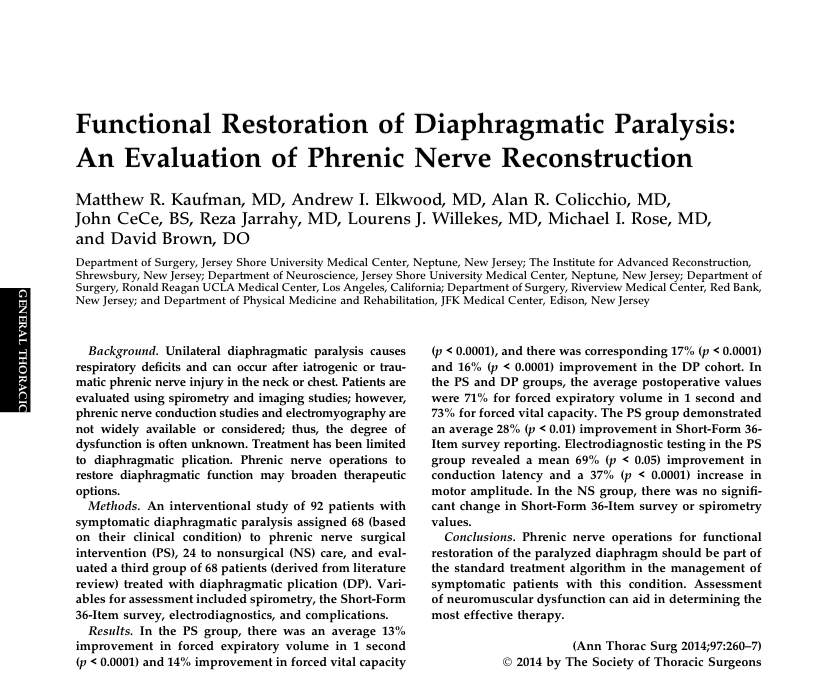FAQs About Diaphragm Paralysis
If you or a loved one has been diagnosed with diaphragm paralysis, you may be feeling overwhelmed and have many questions about the condition. We understand that managing this medical condition can be challenging, which is why we want to provide you with the answers you need. In this article, we will address some of the most frequently asked questions about diaphragm paralysis, providing you with the information and support you need to navigate your treatment journey. Our goal is to help you better understand the condition and how it can be effectively managed so that you can feel empowered and confident in your treatment decisions.
What is diaphragm paralysis?
.jpg?width=250&height=333&name=woman-short-of-breath%20(1).jpg) Diaphragm paralysis is a medical condition where the diaphragm muscle, which plays a crucial role in lung function, becomes weakened or paralyzed. This can happen due to trauma, surgery, or damage to the phrenic nerve.
Diaphragm paralysis is a medical condition where the diaphragm muscle, which plays a crucial role in lung function, becomes weakened or paralyzed. This can happen due to trauma, surgery, or damage to the phrenic nerve.
What causes diaphragm paralysis?
Diaphragm paralysis can be caused by various factors, including trauma, surgery, damage to the phrenic nerve, neurological conditions, or viral infections.
Can diaphragm paralysis be cured?
The treatment options for diaphragm paralysis can improve symptoms, but a complete cure may not be possible. The best course of action is to consult with a physician to determine the most appropriate treatment plan.
What are the long-term effects of diaphragm paralysis?
Long-term effects of diaphragm paralysis can include reduced lung capacity, respiratory failure, and decreased physical activity due to shortness of breath. However, with proper management and treatment, most patients can lead a relatively normal life.
Is diaphragm paralysis a life-threatening condition?
In severe cases, diaphragm paralysis can be life-threatening, particularly if it causes respiratory failure. However, most cases can be successfully managed with treatment.
How is diaphragm paralysis diagnosed?
Several diagnostic tests and procedures can be used to diagnose diaphragm paralysis. Imaging procedures, such as chest X-rays, CT scans, fluoroscopic evaluations, thoracic ultrasounds, and MRIs, can be helpful. Diagnostic tests, including phrenic nerve stimulation tests, electromyography (EMG) tests, pulmonary function tests, trans diaphragmatic pressure measurements, and sleep studies, may also be used.
What are the symptoms of diaphragm paralysis?
Some patients with paralysis of the diaphragm may not present any symptoms, while others may experience shortness of breath, difficulty sleeping, or fatigue.
What are the treatment options for diaphragm paralysis?
Diaphragm paralysis treatment depends on the underlying cause of the condition. Phrenic nerve surgery, diaphragm pacemakers, surgical plication, and diaphragm muscle replacement are among the possible treatments available.
What is phrenic nerve surgery?
Phrenic nerve surgery is a procedure that involves repairing or reconstructing the phrenic nerve to restore respiratory function. Surgeons use advanced nerve repair techniques to restore function to the injured nerve and affected muscles.
What is a diaphragm pacemaker?
A diaphragm pacemaker is a device that works similarly to a cardiac pacemaker. Electrodes are placed along the phrenic nerve or the diaphragm muscle, and electrical signals are sent through the pacemaker, causing the muscle to contract. This procedure is also known as phrenic nerve pacing.
What is a diaphragmatic plication?
Diaphragmatic plication is a surgical procedure that involves reshaping or repositioning the diaphragm to help the lungs inflate properly. This procedure is used for diaphragm paralysis that is not caused by phrenic nerve injury.
What is a diaphragm muscle replacement?
Diaphragm muscle replacement is a surgical procedure that transfers healthy muscle tissue from a donor site in the patient's body, replacing diaphragm tissue that has been irreversibly damaged. This procedure is used for patients who are not candidates for phrenic nerve surgery, a pacemaker, or who have previously had surgical plication.
What is the recovery process after treatment for diaphragm paralysis?
The recovery process can vary depending on the type of treatment received. Patients who undergo phrenic nerve surgery or diaphragm pacemaker implantation typically experience a gradual improvement in breathing over several weeks to months. Patients who undergo diaphragmatic plication or muscle replacement may require a longer recovery period and more intensive rehabilitation.
Can diaphragm paralysis recur after treatment?
In some cases, diaphragm paralysis can recur after treatment, particularly if the underlying cause of the condition is not addressed. Regular follow-up with a physician is recommended to monitor for any recurrence of symptoms.
Where can I receive treatment for diaphragm paralysis?
If you or a loved one is suffering from diaphragm paralysis, it's important to seek help from experienced medical professionals. The Institute for Advanced Reconstruction is one of the few places in the world offering phrenic nerve reconstruction surgery, diaphragm pacemakers, and diaphragm muscle replacement. Their team of board-certified surgeons in NJ has performed over 500 successful phrenic nerve reconstructive surgeries to date.
To learn more about your treatment options for diaphragm paralysis, contact us today.








